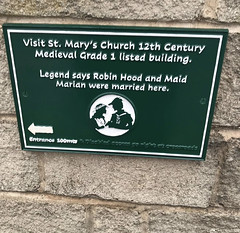Commemorated on 3 plaques
Robin Hood - Wentbridge. One of the only place names that can be located in 'A Lytell Geste of Robyn Hode' (c.1492-1534) is the Sayles now known as Brockadale, Wentbridge. 'And walke up to Saylis, And so to Watlinge Stret (e), And wayte after some unkuth gest, Up chance ye may them mete'.
the bridge, Wentbridge, United Kingdom where they visited
This statue of Robin Hood with its complementary plaques was presented to the City of Nottingham by Philip E.F. Clay Esq to commemorate the visit of the Princess Elizabeth and The Duke of Edinburgh on the 28th June 1949 during the city's quincentenary celebrations
Nottingham Castle - Outer Bailey Wall - Castle Road, Nottingham, United Kingdom where they is commemorated
Visit St. Mary's Church 12th Century Medieval Grade 1 listed building. Legend says Robin Hood and Maid Marian were married here.
Swinecote Road, Edwinstowe, United Kingdom where they was



